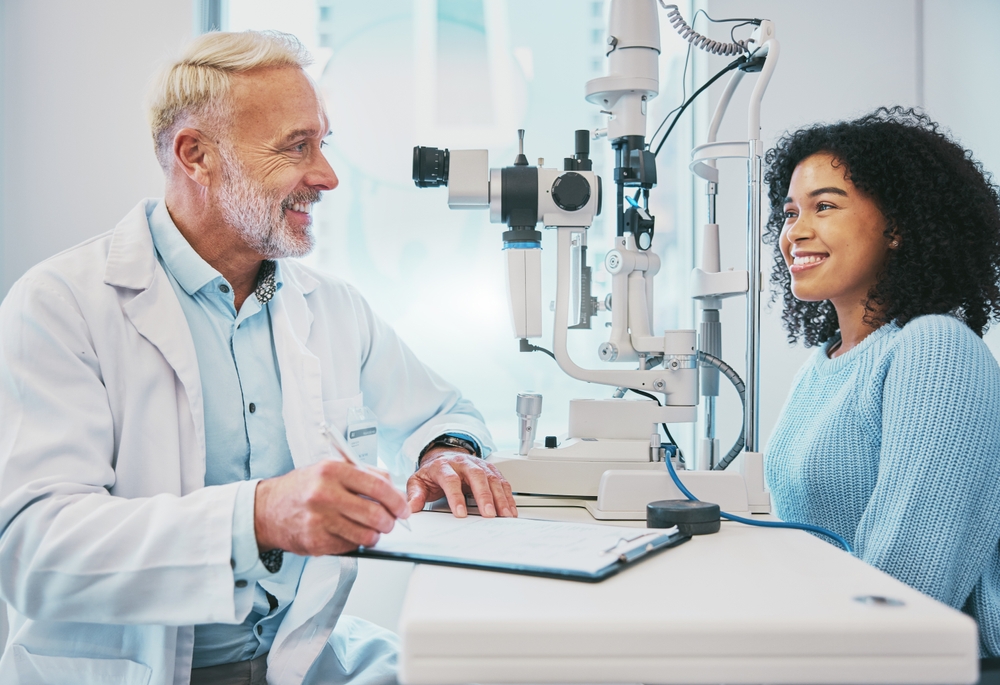In our increasingly digital world, computer eye strain has become one of the most common complaints we hear at Blaine Eye Clinic. Whether you’re working from home, studying online, or simply enjoying your favorite streaming service, prolonged screen time can leave your eyes feeling tired, dry, and uncomfortable.
The good news is that computer eye strain, also known as digital eye strain or computer vision syndrome, is entirely preventable with the right knowledge and habits. Keep reading to learn how you can reduce eye strain when using a computer.
What Exactly is Computer Eye Strain and Why Does it Happen?

Computer eye strain occurs when your eyes become fatigued from intense use of digital devices. Unlike reading a book or looking at printed materials, computer screens present unique challenges for your visual system.
Digital screens emit blue light, refresh at high frequencies, and often display text and images that may be slightly blurry or pixelated. When you focus on a screen, your eyes work harder to process this information, leading to fatigue.
The primary culprit behind computer eye strain is reduced blinking. Normally, we blink about 15-20 times per minute to keep our eyes moist and comfortable. However, when concentrating on a screen, this rate can drop to as low as five blinks per minute.
This dramatic reduction in blinking means your eyes aren’t getting the natural lubrication they need, resulting in dryness and irritation.
Another thing to note is that the muscles that control your eye’s focusing mechanism become overworked when staring at a fixed distance for extended periods. Your eyes naturally want to relax and look into the distance, but computer work forces them to maintain constant near focus, creating muscular tension and fatigue.
How Should I Position My Computer Screen to Minimize Eye Strain?

Proper screen positioning is crucial for comfortable computer use and often provides immediate relief from eye strain symptoms.
Your monitor should be positioned approximately 20-26 inches away from your eyes, roughly an arm’s length. This distance allows your eyes to focus more naturally without overworking the focusing muscles.
The top of your screen should be at or slightly below eye level. When your screen is too high, you naturally tilt your head back, which can strain your neck and change the angle at which your eyelids cover your eyes, leading to increased dryness. If your screen is too low, you’ll crane your neck forward, creating tension in your neck and shoulders that can indirectly affect your eye comfort.
Screen angle matters too. Tilt your monitor slightly backward, so you’re looking down at the screen at a slight angle. This positioning mimics the natural downward gaze we use when reading and helps ensure your upper eyelids provide better coverage of your eyes, reducing tear evaporation and maintaining moisture.
What Lighting Conditions Work Best for Computer Use?
Creating the right lighting environment can dramatically reduce eye strain and improve your overall comfort during computer use. The key is to minimize contrast between your screen and the surrounding environment while avoiding glare that can cause your eyes to work harder.
Ambient lighting should be about half as bright as typical office lighting. Harsh overhead lighting can create glare on your screen and force your pupils to constantly adjust between the bright surroundings and your monitor. Instead, use softer, indirect lighting sources positioned to the side of your computer rather than directly behind or in front of it.
Pay special attention to windows and their impact on your workspace. Natural light is wonderful, but when it creates glare on your screen or streams directly into your eyes, it becomes problematic. Position your monitor perpendicular to windows when possible, or use blinds or curtains to control the amount of natural light entering your workspace. If you must face a window, consider using a monitor hood or adjusting your screen’s brightness to compensate for the ambient light.
Can the 20-20-20 Rule Really Help?
The 20-20-20 rule has become the gold standard recommendation for preventing computer eye strain, and for good reason. Every 20 minutes, look at something 20 feet away for at least 20 seconds. This simple practice gives your focusing muscles a chance to relax and reset, preventing the fatigue that builds up from prolonged near work.
However, the 20-20-20 rule is just one part of a comprehensive approach to eye health during computer use. Conscious blinking exercises can be equally important.
Make an effort to blink fully and deliberately several times throughout your work session. You can even practice the “blink squeeze” technique: close your eyes gently, squeeze them shut for two seconds, then open them slowly. This helps redistribute your tear film and provides deeper moisture to your eyes.
When Should I Consider Professional Help For My Eye Strain?

While most computer eye strain can be managed with proper habits and environmental adjustments, there are times when professional evaluation becomes necessary. If you experience persistent eye strain despite implementing these strategies, it may indicate an underlying vision problem or eye condition that requires correction.
Uncorrected refractive errors, even minor ones, can be significantly magnified during computer use. Dry eye syndrome is one condition that can masquerade as simple computer eye strain.
If your eyes feel persistently dry, gritty, or irritated, even when you’re not using a computer, you may have an underlying dry eye condition that requires professional treatment. Modern dry eye treatments have evolved significantly and can provide lasting relief.
If you experience symptoms like double vision, persistent headaches, or eye strain that doesn’t improve with rest, these could indicate more serious underlying conditions that require prompt professional attention. Regular comprehensive eye examinations are essential for maintaining optimal eye health, particularly for those who spend significant time on computers.
Are you experiencing symptoms of digital eye strain? Schedule an appointment at Blaine Eye Clinic in Blaine, MN, today to discuss personalized solutions for your eye comfort and learn about specialized treatments that can help you work and play comfortably in our digital world.





